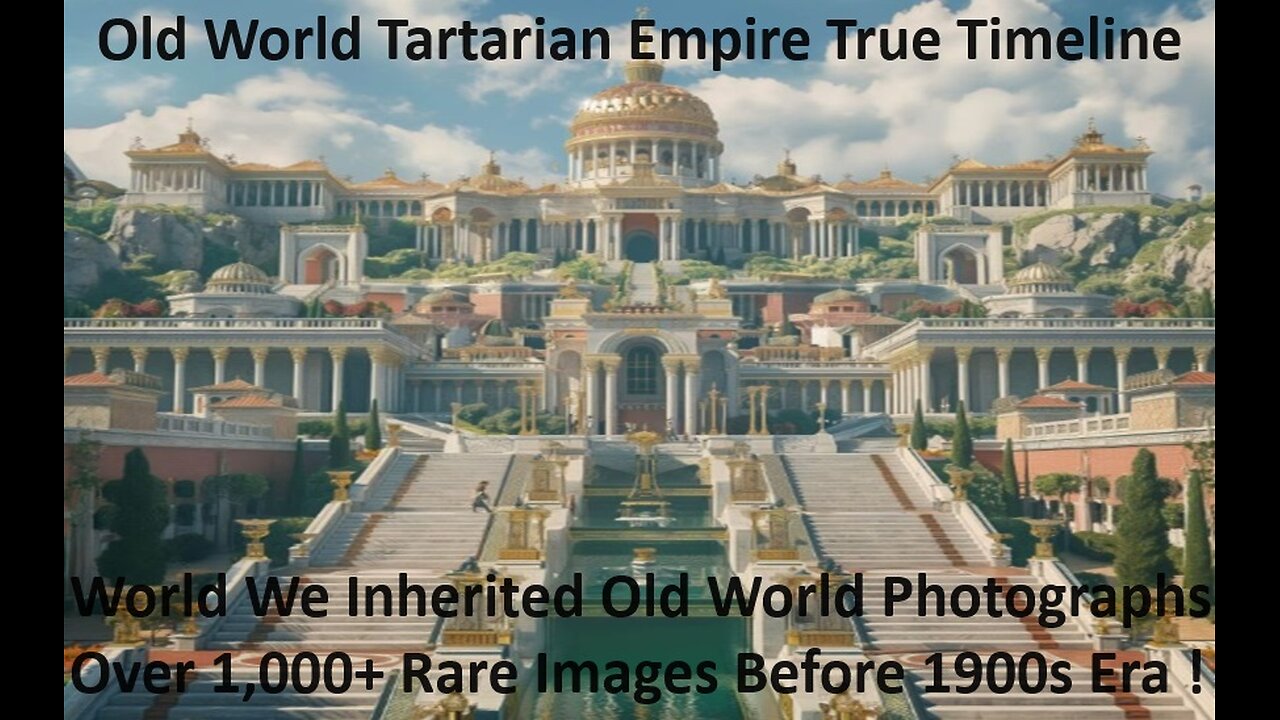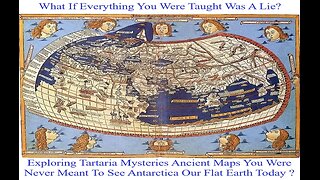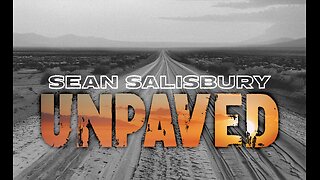Premium Only Content

World We Inherited Old World Photographs Over 1,000 Images Before 1900s Era
The True World We Inherited Old World Photographs Pre-Modern Buildings That We Venerate Are Sometimes Said To Be More Than 1,000 Years Old. Old World Tartarian Empire Timeline And The Old World Tartarian Empire Is A Conspiracy Theory That Proposes The Existence Of A Lost Civilization That Was Wiped Out By A Global Catastrophe, Known As The “Mud Flood.”
According to this theory, the Tartarians were a highly advanced civilization that built many of the world’s most iconic structures, including the pyramids, the White House, and the buildings of the 1915 World’s Fair.
Early History (Before 1490s)
The Tartarian Empire is said to have existed as late as the 19th century, with its own flag, government, and place on the map.
The empire is believed to have been weakened by wars, including the 1666 burning of London and the 1775 weakening of Tartary.
The Tartarians are also said to have been involved in the construction of ancient structures, such as the pyramids and the White House.
Collapse and Wipeout (1490s-1800s)
The Tartarian Empire is said to have collapsed in the 1490s due to a series of catastrophes, including a “mud flood” that destroyed much of the world.
The empire was severely weakened, and many of its structures were destroyed or hidden.
The Tartarians are said to have been wiped out by a global catastrophe, with many of their achievements and knowledge lost to history.
Modern Era (1800s-Present)
The Tartarian Empire is said to have been covered up by a global conspiracy to suppress its existence and achievements.
Many of the world’s most iconic structures are believed to have been built by the Tartarians, including the buildings of the 1915 World’s Fair.
The theory proposes that the Tartarians were a highly advanced civilization that was wiped out by a global catastrophe, and that their achievements and knowledge were lost to history.
Key Events and Dates
1490s: The Tartarian Empire collapses due to a series of catastrophes, including a “mud flood.”
1666: London is burned, weakening the Tartarian Empire.
1775: Tartary is severely weakened.
1800s: The Tartarian Empire is said to have been wiped out by a global catastrophe.
1915: The buildings of the World’s Fair are built, allegedly by the Tartarians.
20th century: The Tartarian Empire is said to have been covered up by a global conspiracy to suppress its existence and achievements.
Conclusion
The Old World Tartarian Empire is a conspiracy theory that proposes the existence of a lost civilization that was wiped out by a global catastrophe. According to this theory, the Tartarians were a highly advanced civilization that built many of the world’s most iconic structures, and their achievements and knowledge were lost to history. While there is no concrete evidence to support this theory, it remains a popular topic of discussion and speculation among conspiracy theorists and enthusiasts.
The Lost Whole World Empire of Tartaria You have heard of the ancient lost civilizations of Atlantis. Perhaps you’ve also heard about the lost continents of Lemuria and Mu. You’ve heard me talk about beliefs in the lost cradles of civilization Hyperborea and Ultima Thule. But have you heard about the lost empire of Tartaria? Depending on your interests and thus the calibration of your YouTube recommendation and search algorithms and the pages you find promoted to you on Facebook, you may have learned a great deal about this globe-spanning mega-civilization in recent years. For example, you may have been surprised to find out that this ancient civilization, which originated in central Eurasia as a vast kingdom encompassing most of Siberia, was so successful that it spread around the world, even into the Americas, and that even today we can see the remnants of the civilization’s grand architecture. Your surprise may have turned to wonder and dismay as you learned of a great worldwide catastrophe, a flood akin to Noah’s but composed of mud that destroyed most evidence of this magnificent civilization. Your wonder and dismay likely further turned to shock and outrage as you learned of a global conspiracy to suppress the history of the Tartarian Empire, to cover up the existence of this mud flood, and to claim the impressive accomplishments of their advanced culture as our own. So throw out everything you know about the history of the world, disregard everything you think you understand about ethnology, geography, architecture, and geology, and prepare to be awakened from the sleep of ignorance, liberated from the herd of the sheeple, and initiated into the mystery of Tartaria!
If you’re still reading, I’ll come clean. I don’t actually believe this claptrap. But there is something very satisfying to me about the idea that some proponent of the Tartarian Empire conspiracy mythos might stumble upon or seek out this blog post and think at first that I’m promoting this nonsense, when actually this is perhaps the most absurd pseudohistorical conspiracy delusion I’ve ever heard. It cannot be taken seriously, making it a perfect topic for my April Fools episode. However, there are other reasons I feel compelled to address this somewhat obscure claim now. First, it is new and growing. Some have likened it to Qanon because of its agglomeration of other conspiracy claims, and while it is still in its infancy, it seems important to make the public aware of it and its rather surprising implications. According to Brian Dunning, whose Skeptoid blog and podcast covered it briefly about a year ago, the Tartarian Empire claims exist solely online, having first appeared on Youtube conspiracist channels around 2016 and gaining traction in 2017 and beyond on Reddit, Facebook, and elsewhere. He confirmed this using Google Trends (though when I tried to reproduce his findings, I was seeing it spike more in 2018). A quick search of word frequency in publications using Google Ngram corroborates that the topic became more common in the mid- to late 2010s but also suggests that it was not a purely online phenomenon, although any early conspiracist publications could very well have been inspired from online content, rather than vice-versa. However, the reliability of these tools in determining the origin of such pseudohistories and conspiracy claims is decidedly questionable. For example, it is entirely possible that these conspiracy claims crossed over into the English-speaking world from foreign language publications that aren’t mined in an Ngram search, or from online content in another language that, if I understand the tool correctly, wouldn’t show up in a Google Trends search, even if it were set to conduct a worldwide search, because the keyword used is in in English. This appears to be the case with the claims about a global Tartarian Empire, as there is good reason to believe this pseudohistory originated in Russia and may have spread to the West as online propaganda or disinformation. So, surprisingly, this ridiculous topic is actually very relevant to current events, particularly the ongoing war and humanitarian crisis in the Ukraine. But I will get to that. Let us start with a simple refutation of the Tartaria mythos.
It has been suggested that the entirety of the Tartaria conspiracy myth can be blamed on conspiracists looking at historical maps and getting confused because of their ignorance of certain aspects of history. In truth, there appears to be something far more insidious behind this conspiracy myth than simple misunderstanding and well-meant speculation, but let’s have a look at this explanation just the same, as we will have to address the name Tartaria anyway. So the idea goes that the whole thing is due to the fact that many old maps label massive swathes of inner Eurasia as Tartaria, or Tartary. It is claimed that, lacking the knowledge of what this term referred to, conspiracists jumped to the conclusion that there must have been a huge kingdom or nation-state called Tartaria that has since disappeared. From there, the theory goes, they let their speculation about this presumably lost civilization run wild. It is certainly true that these old maps using the label of Tartary or Tartaria are frequently raised as evidence for these outlandish conspiracy claims, and their proponents do indeed reject the simple and historically accurate explanation for why these regions were called Tartary. Prior to the 18th century, the West lacked much knowledge about the peoples and societies within Siberia and Central and Inner Asia and simply called all of them “Tatars”, which then became “Tartars,” and their lands “Tartary.” It was a blanket term, similar to the way ancient Greeks called all the lands northeast of Europe Scythia, and any nomadic people from that vague area came to be called Scythians. Some scholars suggest the initial name “Tatar” derived from a Chinese word, dada, which dated to the 9th century C.E. and was used to refer to any nomads north of China. Indeed, it was the bellicose northern peoples of the Eurasian Steppe that the Chinese had built the Great Wall to keep out who would eventually come to be called “Tatars” by the West, such as the Manchu and Mongol peoples, as well as Turkic tribes. As mentioned in my episode on Prester John, a legend that somewhat coincides with Tartaria claims since it talks of a magical kingdom in the same region, the term “Tatar” appears to have become “Tartar” because of a racist pun. According to Matthew Paris, King Louis IX of France, hearing news about the hellish ravages of Mongol forces invading Europe, said of the so-called Tatars, “Well, may they be called Tartars, for their deeds are those of fiends from Tartarus,” which of course was the Latin name for Hades. Thus the corruption “Tartars” was supposedly coined, basically calling the Mongol hordes demons from hell. As the West did not have much concrete knowledge of the political geography of the region from whence these hordes had come, European cartographers indiscriminately slapped the name Tartary, or Tartaria, onto vast tracts of land. In subsequent centuries, the label was persistently applied to a wide range of distinct peoples and regions, such that later maps might distinguish Lesser from Greater Tartary, or Eastern from Western Tartary. Eventually, as ethnological knowledge of the region’s peoples grew, further distinctions had to be made, such that those in Manchuria were called Manchu Tartars, and those in the eastern reaches of the Russian Tsardom were called Muscovite Tartars. Gradually, the term was dropped altogether, with only the occasional remnant to be found. As will be seen, the origin of the Tartarian Empire conspiracy claims found online today are not the result of simple ignorance of the story behind some old cartographic labels, but this ignorance is clearly exploited by or feeds into the conspiracy claim, providing plenty of fodder for supposed primary source evidence that may seem convincing to a lay person who encounters these conspiracy claims online.
It is because of such out of date and inaccurate maps, along with a heaping portion of racial stereotyping, that the belief in a Tartarian Empire in the Americas can be found. That’s right, we are not only talking about an inner Eurasian lost civilization. As I indicated in the beginning, believers claim the remnants of a lost Tartarian Empire can be found all over the United States as well. As evidence, they will cite maps from the 17th century that happen to have the word “Tartorum” near the Bering Strait and visually group North America with Eastern Asia according to the same color. With a simple translation of the Latin, they would be able to tell that the blurb with the word “Tartorum” is describing the Mongol tribes on the other side of the strait, not in North America, and describes a simple rural life that is very different from the technologically advanced civilization they imagine Tartaria was. Likewise, they will bring up a 19th century map of the “Distribution of Races in the World” that, again, color codes sections of Eurasia and much of North America to indicate the presence of the same culture. This racist 19th century map chooses the color yellow for Asia and these portions of North America, and tellingly, it labels these areas Mongolian, not Tartarian. The cartographer appears to have mistakenly conflated Mongolian and Inuit cultures, as the portions of North America identified as Mongolian are predominately north of the Arctic Circle. Of course, in the distant past, Native American peoples likely did migrate across the strait and were distantly related to Eurasian nomads. Specifically, ethnologists recognize that the Yupik aboriginal peoples dwell in both Alaska and Siberia. But again, we are talking about rural nomads, not an advanced civilization that, according to believers, is responsible for the construction of architecturally magnificent edifices. Nevertheless, to the proponents of the Tartarian Empire fiction, these cherry-picked maps are evidence that Grand Tartary, the mythical civilization that they have built up in their minds to Atlantean proportions, was present in the Americas, and though their own false evidence would suggest it could only be found above the Arctic Circle, they claim it was present everywhere. As proof, they point to almost any ornate building constructed in any architectural style other than modern, and they say that must have been a Tartarian structure, because we don’t build things like that in our culture. This may sound like hyperbole, but it’s not. They really do point to any pre-modern structure that is especially impressive and elaborately decorative, and they claim it was not built, could not have been built, by builders of our culture.
In some ways the conspiracist proponents of a global Tartarian Empire are traditionalists, or nostalgists. They seem to value only an old-fashioned or ancient style of building and reject all modernist architecture as ugly, nondescript, and thus inferior. One Norwegian Youtuber focused on Tartaria, Joachim Skaar, lumps all of modernist, and therefore non-Tartarian, architecture together under the label of Brutalism, although that is a very specific offshoot of Modernist architecture that emerged in the 1950s and declined in the 1970s. However, the name and the aesthetics provide a striking counterpoint to what he and others call Tartarian architecture, which again lumps together many known styles, from Classical, Baroque, Gothic and Renaissance to Beaux Arts, Neoclassical, Second Empire and Greek Revival. Again, any sufficiently ornate building, with columns supporting entablatures with carved friezes and cornices with scrollwork, or any building with an especially elaborate roof like a mansard or a cupola or a large dome, seems, in their fevered imaginations, to be a relic of this lost civilization. As evidence, they hold up old photos from 19th century America, in which can be seen such grand edifices, usually municipal buildings like city halls or state capitols, rising above simple wood frame houses and shacks, or on otherwise empty stretches of dirt fields. To them, these are evidence that 19th century Americans were living among the ruins of this vanished civilization, when in fact the photos depict nation building. With a basic grasp of the fact that the construction of such government buildings was well funded, and that architects were specifically sought out and well paid to design impressive architectural structures, it’s quite clear why such projects were initially surrounded by empty space and simple A-frame clapboard hovels. But like most conspiracists, the Tartarian Empire proponents believe there are secrets to uncover in almost any old book or photo they pore over, no matter how widely available they might be. They find beautiful old buildings that no longer exist, and they decide they have uncovered another clue about the destruction of Tartarian structures. For example, the Chicago Federal Building, whose dome was larger than the U.S. Capitol’s dome, but which was demolished after about 60 years, or the slender, 27-story Singer Building in New York City, which for a time was the tallest building in the world but was leveled in the 1960s. Their speculation about the ancient and mysterious origins of such buildings simply disregard their known history. To wit, the head of the Singer Manufacturing Company, makers of the famous sewing machines, commissioned the Singer building as their New York Headquarters and hired architect Ernest Flagg to design it. Such historical details, to the Tartaria conspiracists, are just more lies covering up the truth.
Perhaps the most absurd claim they’ve made is that the impressive temporary complex of ornate facades built out of straw and plaster of Paris for the 1893 World’s Fair in Chicago—the so-called White City—was actually a grand Tartarian metropolis that “they” have pretended was not real. Much of their idiotic claims boil down to not just ignorance of history, but amateurish misunderstandings about architecture that I imagine would really gall any actual architects. They point to the fact that grand buildings of certain distinct styles can be found all over the world, but of course that is because architectural trends spread internationally. They claim that the shift away from these ornate buildings that are so aesthetically pleasing to them, and the movement toward the concrete and steel architecture of modernism, is a clear sign of the disappearance of the Tartarian culture, when in fact, there are plenty of books written by Modernist architects and city planners like Le Corbusier that expound on their reasoning and argument for moving away from more classical styles. And finally, they claim that our culture simply couldn’t have produced such beautiful structures, and yet plenty of New Classical architects design such buildings even today. Take for example, the neo-Gothic Whitman College at Princeton, built in 2002, or the Classical Greek architecture of the Schermerhorn Symphony Center built in Nashville, the so-called Athens of the South, in 2006. Simply put, one gets the impression that these Tartarian Empire Youtubers and Reddit posters are just basement dwellers in boring towns who have only recently discovered the beauty of fancy buildings and simply cannot believe such structures are American. Instead, they envision a massive mega-culture of advanced builders. Joachim Skaar, the aforementioned Youtuber, has been quoted as claiming, “The same people that built the Capitol in Washington built the pyramids in Egypt,” and that gives us a sense of the great depths of ignorance displayed by these conspiracists.
Equally absurd are their explanations for why there does not exist ample archaeological evidence of this widespread culture, aside, from, oh, say, all the surviving buildings they claim are artifacts of the culture and all the photographs of their buildings that are no longer standing. Well, they say there was a worldwide catastrophe that destroyed much of their culture. It was much like the Flood of Genesis, in that it swept into every Tartarian city across the globe, destroying the inhabitants and their records and monuments. They call it the “great reset.” Unlike the biblical flood, though, this was a “mud flood,” and in its wake, entire grand Tartarian cities were left entirely or partially buried. Just what would cause such a global flow of mud is not typically clarified. Some have suggested that it was the result of a worldwide volcanic event, caused by mud volcanos. Mud volcanos are real, and instead of producing magma flows they produce slurries of warm mud. However, even some cursory research into mud volcanos would reveal that they are typically small and don’t cause mass destruction. In fact, they are often identified more as hot springs, and can be enjoyed as natural mud baths. It’s pretty clear some Tartaria “researcher” went looking for a feasible reason for the “mud flood” they invented, found mention of a mud volcano, and said “Bingo!” not bothering to read much more into the topic. But of course, anyone who would believe in a global mud flood isn’t thinking too hard about the science of geology or the analysis of strata performed at any dig site that could handily disprove their “theory.” But they still find supposed evidence for their mud flood, once again in old photos. They bring up black and white photos from the 19th century that show people digging, whether employing hand shovels, mule teams, or steam shovels, especially if there is a fancy building around them. Of course, civic engineering requires a lot of digging like this, even today. Hills must be flattened and depressions filled in order to make streets flat. It’s no great mystery. But Tartarian Empire conspiracists go further, pointing to photos of Gilded Age buildings with windows at ground level and saying that they all appear to be sunken into the ground. Again, these “theorists” seem woefully unfamiliar with buildings generally, but maybe they aren’t basement dwellers after all, since if they were, they would easily recognize these as basement windows. But perhaps the most ridiculous thing about this mud flood aspect of their claims is that, since they’re using photos from the 1800s as evidence, they played themselves and had to place their supposed worldwide mud flood catastrophe in the 19th century. That’s right. These geniuses claim that a global catastrophe happened sometime between the Industrial Revolution and the Gilded Age, and there is no record of it anywhere, and they don’t even bother explaining how it only seemed to affect the Tartarians and us lousy non-Tartarians escaped it just fine.
But hold on! The other element of the so-called “great reset,” besides the global destruction caused by the mud flood, was the purposeful erasure of Tartarian history. Or at least, that’s what they claim. In fact, believers in Tartaria claim that most major armed conflicts of the 19th and 20th centuries were actually about Tartaria. They say Napoleon’s 1812 invasion of Russia was really a war against Tartaria, and that after the mud flood, the World Wars of the 20th century were all actually just excuses to destroy all remaining traces of Tartaria. What is their evidence of such a cover-up? Well, they too use Google Ngram, and they find it suspicious that use of the words “Tartaria” and “Tartary” plummet to nonexistent following the 19th century. But of course, we know why that is. It’s because we stopped using an inaccurate blanket term that was actually a pun suggesting they were from hell and instead started calling them Mongols or some other more accurate name. However, never let it be said that conspiracy speculators aren’t ingenious, for they managed in their blindly focused keyword searches to turn up an obscure declassified CIA report on “National Cultural Development under Communism.” In it, there exists a paragraph that is presented as smoking gun evidence of a cover-up of Tartaria’s history. It reads as follows:
…let us take the matter of history, which, along with religion, language and literature, constitute the core of a people’s cultural heritage. Here again the Communists have interfered in a shameless manner. For example, on 9 August 1944, the Central Committee of the Communist Party, sitting in Moscow, issues a directive ordering the party’s Tartar Provincial Committee “to proceed to a scientific revision of the history of Tartaria, to liquidate serious shortcomings and mistakes of a nationalistic character committed by individual writers and historians in dealing with Tartar history.” In other words, Tartar history was to be rewritten—let us be frank, was to be falsified…
The obvious problem here, of course, is that the CIA appear to be condemning Communist revision of “Tartar” history, which simply isn’t in keeping with the idea that the erasure of Tartarian history was a global conspiracy, which likely would have to involve the CIA. But the real issue is that this oft-used quote is taken entirely out of context. Only this paragraph in the entire report mentions “Tartaria,” and this is only because they are quoting a Communist committee that uses the term. The rest of the report makes it clear that the CIA is talking about Communist attacks on Islam and the Muslim peoples within their authority. Furthermore, if they even gave enough context to quote the entirety of the last sentence, it would be revealed that the history of these Muslim people was being rewritten, or falsified, “in order to eliminate references to Great Russian aggressions…so that the Russians always appear in a good light.” And this, the fact that Russians have long been engaged in a revision of history, producing a pseudohistory intended to serve their political purposes and falsely burnish their image, leads us to what may be the true origin and sinister purpose of this batshit crazy conspiracy claim.
The way that the Tartaria conspiracy claims blithely do away with massive parts of world history somewhat reminds me of the claims of chronological revisionists that I previously discussed at great length in a three part series. Indeed, searching Google Trends for Tartaria, one sees Phantom Time, the chronological revision theory of Herbert Illig that I spoke about in my series, listed as a related query. Furthermore, it has been suggested that the origins of the Tartaria claims can actually be traced to the chronological revisionist writings of Russian mathematician Anatoly Fomenko. I encourage listeners to go back to my Chronological Revision Chronicles series, specifically Part One, The Fomenko Timeline, to hear more about this figure and his theories. In brief, Fomenko claims to use statistical analysis and astronomical data to prove that entire eras of accepted history didn’t actually occur. Instead, he argues that much of accepted history is actually duplicated from medieval history. He has been nicknamed The Terminator due to his penchant for finding reasons to delete vast swathes of history, and his rewriting of biblical history has drawn the ire of the Russian Orthodox church. But Fomenko found popularity and success in writing about history, with his “New Chronology” book series, History: Fiction or Science, bringing him far more fame than he had ever earned as a mathematician. He claims to be politically impartial, but historians and critics of his work, especially Konstantin Sheiko, who wrote extensively about the implications of Fomenko’s claims in his PhD thesis, point out that Fomenko’s work fits clearly into an ethno-nationalist tradition of producing pseudohistory and alternative history that presents the Russian people and their history in certain favorable ways. As the CIA report I referenced indicates, this historical negation, denialism, and revisionism had been perpetrated by the Soviets, but as Sheiko describes, it continued, in a somewhat different vein, after the fall of the Soviet Union, as Russia sought out some post-Soviet identity. Among these pseudo-historians, Russian identity, its greatness, is in its power and control of space on the world map, thus they find reason to suggest that a great Russian Empire existed long before the Soviet Union or the Tsardom of Rus. Others in this category see Russian identity wrapped up in racial heritage, and they trot out the old myth of an Aryan people. Though he feigns academic impartiality, Fomenko’s work is at the forefront of this movement to forge a false ethno-nationalist historical identity for Russia. When he eliminates entire periods of history, he typically claims that they are duplications of Russian ancient history. The Holy Roman Empire? Well that is just the appropriated history of a great Russian Empire. His alternate history is at its heart, one in which the accomplishments of Russia are far greater, and its greatness has been stolen from it and attributed to other regions and historical periods. According to Fomenko, the Mongols, formerly known as Tatars or Tartars, did not exist, as such. Instead, he claims that there existed a vast Slav-Turk Empire, not a Mongol Horde but rather a Russian Horde. In this way, he and other Russians can deny that they ever came under the Mongol Yoke. The Mongol invasion, he claims, was a myth invented by the Romanov Dynasty and the Church. In fact, Genghis Khan was a Russian, complete with European features. So under it all, all the mathematical reasoning, the elaborate statistical and astronomical proofs, behind Anatoly Fomenko’s New Chronology, we see the ugly head of Aryan mythology, of white supremacy, rearing.
Is the Tartaria nonsense actually the New Chronology repackaged? In turn, is it just Russian ethno-nationalist propaganda as the work of Fomenko is revealing itself to be? Well, you could describe both as the myth of a vast Siberian / Inner Asian empire whose history has been stolen and erased. Tartarian conspiracy nuts also scrutinize old portraits of Genghis Khan and speculate that he may have been more European-looking, more white, than he is otherwise portrayed. In their reaction against the historical distortions of Tsarist and Church propaganda, Communists initiated their own revision and falsification of history, as the CIA observed in the aforementioned report, and after the fall of Communism, a new false history has emerged, still intent on painting Russia in the best light, and justifying its geopolitical powerplays. Just as Vladimir Putin today justifies his invasion of the Ukraine with falsehoods, claiming that it has always been a part of Russia and has no historical right to independence, his nationalist rhetoric is validated by, or perhaps inspired by, the pseudo-historian Anatoly Fomenko, who claims that Ukraine has no identity apart from Russia, for its people were always only part of his “Russian Horde.” This pseudo-history tacitly justifies war crimes. So what am I arguing? I suppose I am arguing what others before me have argued: that the Tartarian Empire conspiracy myth originates from Russian disinformation, spread online to the Western world by professional Russian propagandists, and transforming along the way, through a weird digital version of the telephone game, to something almost unrecognizable. This may itself sound like conspiracy speculation, but the fact that Russian propaganda programs are active in spreading disinformation through bots and puppet accounts run out of troll farms is well known. We also know that they are involved with the encouragement of the growth of conspiracy claims. Hell, that goes back a long time before Qanon and COVID-19 conspiracies on social media. Back in the 1980s, the KGB ran a disinformation campaign aimed at encouraging the baseless conspiracy claim that the U.S. government was responsible for the creation and spread of HIV/AIDS. Now, there is a fast-spreading conspiracy theory about the existence of an ancient, suppressed mega-empire that originated in their region, and it is remarkably similar to the ethno-national propaganda Russia’s president spouts as a pretext for expansion, asserting the Russians are just reclaiming what has always been theirs. Tell me that doesn’t sound like there is a connection. What’s really scary is if Putin starts to assert that the ancestral claim of the Russian people extends all the way to America, where the Tartarian Empire is said to have formerly reigned.
As with that other conspiracy mythos, Qanon, that has likely been encouraged every step of the way by Russian disinformation campaigns online, the Tartarian Empire hoax has grown to become a mega-theory as its proponents take a buffet-style approach, incorporating into the myth complex any pet theory or crazy notion they fancy. One can imagine that it’s especially hard to control a conspiracy narrative once it has been fed to the conspiracy nut community. Thus we see claims about the Illuminati come in to explain the worldwide cover-up, or of the Jewish World Conspiracy, which isn’t that surprising considering its connection to Russian claims of Aryan supremacy. To further explain why the existence of Tartaria had to be covered up, conspiracists have incorporated elements of the fantastical claims about Atlantis or hollow earth civilizations: namely that the Tartarians had advanced technology, free wireless energy technology to be more specific, and that the powers that be conspired to hide this from the energy dependent masses. And then, there is the doozy—that Tartaria was actually peopled by giants. Never mind that all the buildings they identify as Tartarian are made for regular size people. They found a few photos of grand, oversized doors, and of course they found statuary and paintings depicting, you guessed it, giants. They link the existence of giants in the lands of Tartary through the tales of Gog and Magog, which have historically been associated with Mongolians, as I discussed in my episode on Prester John. And from there, it just devolved into photoshopped hoaxes of gigantic bones. But the argument against the historical existence of giants deserves to have its own episode and would be too much of a digression here at the end of this one. To conclude, let’s just hope that the fringe nutcases who have taken up the Tartarian standard and run with it online continue to take the idea in such ridiculous and fantastical directions that it becomes ever more laughable, and thus, if we’re lucky, useless as Russian propaganda.
On YouTube videos and Reddit boards, adherents of a bizarre conspiracy theory argue that everything you know about the history of architecture is wrong. In 1908, architect Ernest Flagg completed the Singer Building in Lower Manhattan, a Beaux-Arts showstopper made for the Singer sewing machine company. From a wide base, a slender 27-story tower rose, topped by a mansard roof and a delicate lantern spire.
Every inch dripped with sumptuous detail inside and out; vaulted roofs, marble columns with bronze trim, window mullions with spiral fluting. The lobby was said to have a “celestial radiance.” A book was written just about its construction. For a year, it was the tallest building in the world at 612 feet, and a celebrated landmark for decades after that.
But not for too much longer. Despite its great height, the pencil-thin tower lacked office space. In the 1960s the company sold its ornate headquarters; demolition proceeded in 1967. It’s the tallest building to ever be peacefully demolished.
By any account, it’s a fantastical tale: Once the tallest building in the world and a New York icon, knocked down in just a handful of decades.
For some, it’s too fantastical to believe … or perhaps not fantastical enough. A dedicated group of YouTubers and Reddit posters see the Singer Building and countless other discarded pre-modern beauties and extant Beaux-Arts landmarks as artifacts of a globe-spanning civilization called the Tartarian Empire, which was somehow erased from the history books. Adherents of this theory believe these buildings to be the keys to a hidden past, clandestinely obscured by malevolent actors.
Who? Why? To what possible end? As in many other, more high-profile conspiracy theories, this baroque fantasy doesn’t offer much in the way of practical considerations, logic or evidence. But it’s grounded in some real anxieties, pointing toward the changes wrought by the modern world in general and modern architecture specifically — and rejecting both.
Tartaria rises
Tartarian-themed content is produced for YouTube videos that get picked over on Reddit. The r/Tartarianarchitecture sub, which began in December 2018, has 3,300 members, though not everyone who posts and comments appears to be a true believer. A larger and more general sub that appeared around the same time, r/Tartaria, has 8,700 members. As conspiracy theories go, Tartaria remains obscure; Twitter user @cinemashoebox brought it to many people’s attention last year with this thread, and pseudoscience-debunking writer Brian Dunning recently devoted an episode of his podcast, Skeptoid, to the Tartaria theory, which appears to have first emerged in 2016 and 2017.
The Tartaria storyline is not directly related to the adrenochrome-harvesting Satanic-pedophile cabal that lies at the heart of QAnon, the unfounded conspiracy theory that crashed into the real world in 2020. But it shares some of what Peter Ditto, a social psychologist at the University of California-Irvine who specializes in conspiracy theories, calls QAnon’s “cafeteria quality:” There’s no overarching narrative or single authorial voice interpreting events. It’s just a gusher of outlandish speculation; adherents can pick and choose which elements they want to sign on to.
The overall premise is an alternative history. A vast, technologically advanced “Tartarian” empire, emanating from north-central Asia or thereabouts, either influenced or built vast cities and infrastructure all over the world. (Tartaria, or Tartary, though never a coherent empire, was indeed a general term for north-central Asia.) Either via a sudden cataclysm or a steady antagonistic decline — and perhaps as recently as 100 years ago — Tartaria fell. Its great buildings were buried, and its history was erased. After this “great reset,” the few surviving examples of Tartarian architecture were falsely recast as the work of contemporary builders who could never have executed buildings of such grace and beauty, and subjected them to clumsy alterations.
“I think that it was one worldwide civilization,” says Joachim Skaar, a 26-year-old Norwegian who runs The Tartarian Meltdown YouTube channel. “It was all based on unity, oneness, peace, love, and harmony, which we don’t see in today’s society.”
There’s an arch-traditionalism present in the theory, too. The pre-modern buildings that we venerate are sometimes said to be more than 1,000 years old. “The same people that built the Capitol in Washington built the pyramids in Egypt,” Skaar says.
Reached at his recording studio, Skaar, who works as a plumber, is not an architect or historian, but he has strong opinions on both disciplines. “We have two very different types of architecture,” he says. There’s modern architecture “with the name Brutalism,” which he describes as “square concrete boxes which are designed to be produced very fast, very cheap and very effective.”
And then there’s Tartarian architecture, a label that gets applied to anything that’s particularly ornate and pre-modern, encompassing many Western styles: Classical, Beaux-Arts, Second Empire. The term is also sometimes used for some non-Western structures, like the Taj Mahal. Structures that seem geographically or culturally dislocated, like the Beaux-Arts commercial buildings in Shanghai’s Bund district, are particularly attractive to this theory, as are those that are impressively massive, like the pyramids of Egypt or the Great Wall of China (built, the theory goes, by Tartarians to keep the Chinese out). Anywhere there’s a perceived gap between the refined craftwork of an old building and the “primitive” technology of the horse-and-buggy-era people building it, space for Tartarian speculation pops up.
American cities of the 19th century are often rich with Tartarian appropriation, especially the young settlements of the West, when grand public structures seemed to emerge from the wilderness, surrounded by wood hovels and muddy streets. State capitol buildings and city halls are frequently fingered as palaces of ancient Tartaria rather than Gilded Age municipal buildings. (These photos of the Iowa State Capitol in Des Moines highlight the contrast Tartarian theorists point out.)
The Tartarian milieu is an intensely visual medium, occupied with riffing on photos and maps, picking out apparent inconsistencies and making one-off conjectures instead of weaving together comprehensive timelines. The theory is notably light on reasoning as to why and how the greatest cover-up in history was undertaken, but it does offer a few options for how Tartaria was erased and the great reset propagated. Many say that an apocalyptic mud flood buried its great buildings; some suggest the use of high-tech weaponry to tactically remove Tartarian infrastructure. A consistent theme is that warfare is an often-used pretext to wipe away surviving traces of Tartarian civilization, with the two world wars of the 20th century finishing work that may have begun with Napoleon’s invasion of Russia.
Despite their interest in architecture, most Tartaria theorists do not appear to have backgrounds in the building trades: Many of the more easily refuted arguments spring from very basic misunderstandings of how the built environment works, as well as broader confusion about how buildings function in the economy and culture. An abundance of posters appear convinced that below-grade basement windows in older buildings, for example, are evidence that the building had been “mud flooded,” and the rest of the structure is actually buried deep underground. Sometimes this will get some skeptical pushback (“I think they didn't have lights in the cellar so they build in windows for them?” was how one poster responded), but that’s more of an exception than the rule.
“You see these capital domes all over the world, which, to me, proves that the same people built everywhere.”
Similarly, their grasp of historic labor and material costs is shaky. Before the Industrial Revolution, labor was cheap, so paying artisans to sculpt elaborate masonry — even for relatively humble structures — wasn’t the great expense it seems today, when labor prices are higher and factory-made steel, concrete and glass is cheap; that’s why we see so much of these materials in buildings today, and so much less filigreed terra cotta. One of the most adamant denials in Tartarian circles is that public buildings like schools and post offices were ever built with monumental proportions and elegant aesthetics. They sneer at the wedding-cake-topper Second Empire buildings designed by Alfred Mullett after the Civil War, for example. “How many stamps did you sell to build yourself a post office like this?,” says popular Tartarian YouTuber JonLevi in one of his videos. “Absolutely ridiculous. The post office has always struggled.” (He has more than 100,000 subscribers.)
Some of this confusion is unfamiliarity: Mullett’s U.S. Customs House and Post Office in St. Louis, for example, was a huge federal project, built to process the mail of 10 states and four U.S. territories, not a neighborhood letter depot. But beyond that, there’s a broader refusal to believe that public architecture could ever have been built in an atmosphere of generosity and abundance. This is echoed by their astonishment at the double-height grand lobbies and arched doorways of old buildings, which they see as artifacts not meant for us. (Some theorists surmise that ancient Tartarians were giants.) The Tartarian community seems to have internalized the current era’s predilection for public sector austerity and the resulting aesthetics, which they abhor, more than they realize.
At its core, the theory reflects a fear of how quickly things change. As they look at today’s cityscapes, Tartaria believers see an eerie and alienating place, filled with abstract monoliths that emerged out of nowhere in a brief period of time. They’re skeptical of the rapid rise and development of the U.S., and even more suspicious of how quickly Modernism came to dominate the landscape. One favorite case study, useful for illustrating this aesthetic whiplash, is the grand domed Henry Ives Cobb Chicago Federal Building, built in 1905. Like the Singer Building, it was razed after just 60 years in favor of an icy black Mies van Der Rohe tower.
In one sense, the Tartaria theory is right: With modern architecture, a revolutionary new consensus on how the built environment should look and work did take hold in a very short period of time, conveniently overlapping with the world wars that these theorists see as the tail end of Tartaria’s influence. The world of 1960 indeed looked radically different from the world of 1920. Led by obscure and poorly understood forces (architects), architecture schools truly did throw out the history books to build a new world. But instead of making this excision the work of a colossal global mega-conspiracy worthy of a pulpy airport mystery novel, they wouldn’t shut up about it.
In the Tartarian worldview, we’re a society that doesn’t properly understand or value the built environment, because we’ve been misled about who really built it. When he’s decrying the lack of regard for the cultural legacy of old buildings, Skaar sounds less like a conspiracy theorist than a board member of a preservation nonprofit. “The problem is that people don’t recognize these buildings,” he says. “They walk past them all the time, and they’re fascinated, but they don’t think any more deeply about it. They don’t know what they’re looking at because they have been told something else.”
In search of a fabricated empire
This disregard for architecture’s “true” history moves into a wider rejection of how disposably cheap and commodified the culture at large seems to be. As such, one canonical belief of Tartarian aficionados is that the elaborate temporary pavilions built for late 19th century and early 20th century World’s Fairs were in fact Tartarian capital cities. It strikes them as improbably wasteful that anyone would erect these magnificent complexes, full of fluted columns, domes and pediments, out of plaster of Paris, hemp fiber, and straw, as was done for the 1893 World’s Fair in Chicago. In Tartarian lore, these sites were ancient monuments that were co-opted to teach a falsified history of the world and make a few bucks selling popcorn and Ferris Wheel rides. Then they were demolished, to erase the handiwork of the real builders.
In pointing out the eradication of an ancient culture by an expanding imperial power, Tartarian believers again stumble on something real, but they scramble the protagonists. In the European colonial era, Western nations fanned out over the globe, subjugating and destabilizing numerous non-white civilizations — and building many examples of what’s now considered Tartarian architecture as celebration of these victories. But when YouTuber JonLevi marvels at the Hong Kong Shanghai Bank and the rest of the 1920s banking infrastructure built along Shanghai’s Huangpu River, he doesn’t see the wealth-extracting handiwork of a rapacious 20th century empire: In the Tartaria-verse, these are the stately remnants of a far older and more benevolent one. The theory posits that only Tartarians, not British bankers or Belgian rubber barons, could move culture like architecture across geography.
“You see these capital domes all over the world, which, to me, proves that the same people built everywhere,” says Skaar.
Bastion star forts are another building type that Tartarians are obsessed with: They often point out that these cannon-resistant military fortifications, popular in the 16th and 17th centuries, are found all over Western Europe, like Portugal and the Netherlands, but also quite mysteriously, far away in Asia, in Sri Lanka. But since Sri Lanka was a Portuguese and Dutch colony, it’s not really very mysterious. Military historian Jeremy Black, author of two books on the history of fortifications, says that the geographic reoccurrence of the style reflects how effective Europeans were in spreading this technology across the globe.
This ahistoricism can make the Tartarian architecture community occasionally receptive to reactionaries, racists and anti-Semites. A survey of videos and discussions will turn up all manner of other conspiratorial threads. Along with flat-Earth advocacy, anti-vaccination sentiments and 5G scaremongering, there’s talk of anti-Semitic banking cartel conspiracies and Holocaust denial. Some Tartarian histories recast populations of Central Asia, like Genghis Kahn’s Mongol Empire, as red-haired, blue-eyed, white people — “Silk Road Aryans.”
The persistence of anti-Jewish tropes within current conspiracy theories is likely the result of cultural inertia, says UC-Irvine scholar Ditto. As successive generations of the conspiracy-minded seek evidence to back up their diverging worldview, they find it in texts that may go back centuries, which are riddled with anti-Semitism.
But the face of the villains in the Tartarian narrative is not clearly defined. Skaar blames quasi-mystical “parasites” who thrive off pain and strife, and laments that contemporary life has become a place where “everything is based on tyranny, greed, and slavery.” The Tartaria commentariat is laced with economic discontent; they often decry the evaluation and disregard of buildings purely as salable commodities, untethered from broader notions of cultural legacy and achievement. There’s a reoccurring and implicit understanding that buildings, like the Singer Building, get torn down when they stop making money — the only thing that really matters — and that the world is a vast field of predation, where the rich and powerful consume the poor and weak.
In fact, the governing ideology of the modern architecture that Tartarians despise was a critique of this system. Modernism argued for an egalitarian architecture that would help break the shackles of the past, rejecting backbreaking representational craftsmanship to honor omnipotent kings and divine beings in favor of simple, universal forms that would leverage restraint and efficacy into a broad uplift for the masses. Minus the weirdest stuff — the global mud flood, the ancient energy weapons, the vanished race of giants — the Tartaria theory is just an extreme form of aesthetic moralism, the idea that traditional architecture styles are inherently good and modern architecture is the product of a degenerate culture.
The tastes of the community generally align with traditional architectural revival proponents (some of whom also embrace reactionary and white nationalist politics). This sort of aesthetic nativism flourished during the Trump era, and it appears to have fresh converts in Congress: Recently, representatives Marjorie Taylor Greene and Paul Gosar formed a new caucus dedicated to “uniquely Anglo-Saxon political traditions” and infrastructure that “befits the progeny of European architecture.” The language is different, but the sentiment wouldn’t appear out of place in r/Tartaria.
Holding back a flood of conspiracies
Though the Tartarian Empire seemed to wink into existence in the past few years, the themes its believers explore are familiar ones. Conspiracy theories are a way to channel restive populism in the face of rapid social and demographic change, Ditto says, and there’s plenty of that going around. They are also a way to gather up amorphous fears and put them in a specific place, to make them more manageable. Ditto calls this “over-intentionalization.
“If your fate is controlled by impersonal, systemic forces, it doesn’t offer you much control over your own destiny,” he says. “But if you can localize it to a small group of people whose motives you understand — they are out to get you — then it at least offers some hope that you can overcome their malevolent intentions.”
Belief in conspiracy theories can also be driven by loneliness, isolation and economic hardship, which made a pandemic a fertile Petri dish, and helped QAnon’s believers storm the Capitol by force and through the ballot box. The social atomization forced on us by Covid-19 is a hyperbolic retelling of the Tower of Babel (which has a special place in Tartarian lore) and its attendant anxiety at fracturing and divided cultures. The great reset that erased that tower — and the fabulous, fictional empire that built it — continues to reverberate, splintering us into ever-stranger factions.
And Ditto says it does seem like reality is getting harder to decipher. The internet has made it easier to disseminate misinformation while eroding faith in the media hierarchies that once filtered it out. Polarization and a lack of trust in government and institutions creates a feedback loop, where leaders can’t solve problems because their political bases are too narrow, and the resulting failures engender more distrust. It’s not a new cycle — despite a spike in media attention, there’s not much evidence that conspiratorial thinking is more common now than in years past — but technology can make these currents of collective delusion more powerful, and harder to ignore.
The basic human desires for community, stories (the more outrageous the better) and the need to feel like a protagonist in a wider struggle are what pulls us from moments of real social, economic and cultural dislocation into fabricated histories. Buildings and cities are made to grow old, to outlast people, and to be a testament to these cultural histories. They’re a yardstick for a culture’s ability to endure. When they’re not given the chance to do this, the contradiction can break something loose, and send people scavenging for cultural memory that feels ancient enough to anchor them in an uncertain now.
https://fbd.agency/blog/resource/discovering-the-tartarian-empire/
Real Timeline Of Deception Part 0 Exploring Tartaria 1000 Years
Exploring Tartaria - Old World Secrets Revealed
https://rumble.com/v2u8ef4-real-timeline-of-deception-part-0-exploring-tartaria-1000-years-added-to-ou.html
Real Timeline Of Deception Part 1 Exploring Tartaria 1000 Years
The Timeline Deception - Part I - Exploring Tartaria
https://rumble.com/v2ua8sa-real-timeline-of-deception-part-1-exploring-tartaria-1000-years-added-to-ou.html
Real Timeline Of Deception Part 2 Exploring Tartaria 1000 Years
The Timeline Deception - Part II - Exploring Tartaria
https://rumble.com/v2ubf4w-real-timeline-of-deception-part-2-exploring-tartaria-1000-years-added-to-ou.html
Real Timeline Of Deception Part 3 Exploring Tartaria 1000 Years
The King of Tartaria - Exploring Tartaria
https://rumble.com/v2ueih6-real-timeline-of-deception-part-3-exploring-tartaria-1000-years-added-to-ou.html
Real Timeline Of Deception Part 4 Exploring Tartaria 1000 Years
The Saints - Relics, Reliquaries, & The First Resurrection
https://rumble.com/v2ugl92-real-timeline-of-deception-part-4-exploring-tartaria-1000-years-added-to-ou.html
Real Timeline Of Deception Part 5 Exploring Tartaria 1000 Years
The Saints - The Ruling Class - Exploring Tartaria
https://rumble.com/v2uij7w-real-timeline-of-deception-part-5-exploring-tartaria-1000-years-added-to-ou.html
Real Timeline Of Deception Part 6 Exploring Tartaria 1000 Years
From Atheism, Agnosticism, New Age, Protestantism, to Roman Catholicism
https://rumble.com/v2ujvr6-real-timeline-of-deception-part-6-exploring-tartaria-1000-years-added-to-ou.html
Real Timeline Of Deception Part 7 Exploring Tartaria 1000 Years
The Millennial Kingdom of God - Exploring Tartaria
https://rumble.com/v2uldss-real-timeline-of-deception-part-7-exploring-tartaria-1000-years-added-to-ou.html
Real Timeline Of Deception Part 8 Exploring Tartaria 1000 Years
Magic of the White City 1893 Chicago World's Fair
https://rumble.com/v2un20g-real-timeline-of-deception-part-8-exploring-tartaria-1000-years-added-to-ou.html
Real Timeline Of Deception Part 9 Exploring Tartaria 1000 Years
1000 Years Added To Our History & Dark Ages Never Existed
https://rumble.com/v2uo07i-real-timeline-of-deception-part-9-exploring-tartaria-1000-years-added-to-ou.html
Real Timeline Of Deception Part 10 Exploring Tartaria 1000 Years
Church History - Complete Documentary AD 33 to Present
https://rumble.com/v2uprfu-real-timeline-of-deception-part-10-exploring-tartaria-1000-years-added-to-o.html
Real Timeline Of Deception Part 11 Exploring Tartaria 1000 Years
Christmas Unveiled - Pied Piper - Templars Secret - Saturn's Workshop - Giants Stealing Children
https://rumble.com/v2urmd0-real-timeline-of-deception-part-11-exploring-tartaria-1000-years-added-to-o.html
Real Timeline Of Deception Part 12 Exploring Tartaria 1000 Years
Ancient Cloning Factories - Foundlings - Incubators - Test-Tube Babies
https://rumble.com/v2uu8ck-real-timeline-of-deception-part-12-exploring-tartaria-1000-years-added-to-o.html
Real Timeline Of Deception Part 13 Exploring Tartaria 1000 Years
Homunculus Unveiled - Jesus - Artificial Generation - Liber Vaccae - Lost Esoteric Secrets
Archaix Chronology Anunnaki Sumerian Gods Crystalinks Timelines 2040B.C. 2046A.D.
Archaix 2.0 Doomsday Chronology Five color charts with extensive Legend-chronology; exhibits 62 dates involving 300 events in linear timeline combining the Phoenix and Nemesis X Object appearances, the Mayan Long-Count baktuns and the Anunnaki NER 600 year periods, a history spanning over 74 centuries to May 2040 and November 2046.
The Lost History of Earth (Ewaranon) W0W - A Must See Video Lost Earth
Everything we were taught about the Earth, History, Science, Space, Energy and our Civilization was a lie. This mind blowing documentary will shift your perspective of the world monumentally.
The Secret Life of Symbols with Jordan Maxwell Knowledge of the Heavens, Life on Earth
Ancient Religions From Alpha To Stone Age To Omega To Modern Times To Infinity
This 11.5 Hrs. Full Documentary With Sound Is About Ancient Religions From Alpha To Stone Age To Omega To Modern Times To Infinity.
https://www.boredpanda.com/then-and-now-pictures-changing-world-rephotos/
Everything we were taught about the Earth, History, Science, Space, Energy and our Civilization was a lie. This mind blowing documentary will shift your perspective of the world monumentally.
Antiquitech Tartarian Empire Greatest Story Ever Un-Told Video Very Old 900 Images - https://rumble.com/v36zig8-antiquitech-tartarian-empire-greatest-story-ever-un-told-video-very-old-900.html
Greatest Story Ever Un-Told 10 Parts Set and This 1893 World Columbian Exposition In Chicago Is Really A 1,000 Years Old City From Past Antiquitech Tartarian Empire and the True Believers in the “Tartaria” conspiracy theory that 100s of old world fairs 1801 thru 1940 era are convinced that the elaborate temporary fairgrounds built for events like the Panama-Pacific International Exposition in San Francisco in 1915 and 100s of other city were really the ancient capital cities of a fictional empire !
-
 2:19:00
2:19:00
What If Everything You Were Taught Was A Lie?
16 days agoExploring Tartaria Mysteries Ancient Maps You Were Never Meant To See Antarctica Our Hidden Earth
3.14K5 -
 1:03:08
1:03:08
The Quartering
2 hours agoKarmelo Anthony Update, South Park Apologizes & Today's News!
40K24 -
 55:46
55:46
Sean Unpaved
2 hours agoCam's Take on Hurts, O-Line Essentials, Texans' Super Bowl Dreams, & Hands Outta There!
8.96K1 -
 2:03:41
2:03:41
Tim Pool
4 hours agoThe DEMISE of South Africa & PERSECUTION of White People | The Culture War with Tim Pool
251K51 -
 20:47
20:47
Scammer Payback
7 hours agoWe Turned a Scam Call Center into a Pizzeria
6.18K3 -
 31:04
31:04
Clownfish TV
5 hours agoI Watched FANTASTIC FOUR: FIRST STEPS So You Don't Have To...
6.6K8 -
 1:58:01
1:58:01
The Charlie Kirk Show
3 hours agoLower Legal Immigration + Obama's Immunity? + AMA | Hemingway | 7.25.25
47.4K19 -
 28:44
28:44
The Official Corbett Report Rumble Channel
18 hours agoFrom Age Verification to Digital ID - New World Next Week
15.3K9 -
 7:15
7:15
Adam Does Movies
19 hours ago $0.59 earnedEddington - Movie Review
20.2K1 -
 1:09:43
1:09:43
The Big Mig™
3 hours agoGlobal Finance Forum w/ Guest, Financial Expert Joe Lombardi
12.8K8